The Future Of Flying Is Nearly Here–But You Probably Can’t Afford It
The next 10 years promise to bring radical change to airplane cabins, but it’ll cost you.
1/34 Seymourpowell [Image: Seymourpowell]
BY KATHARINE SCHWAB0
The experience of flying is on the verge of radical change. In 10 years, you may breeze through a line-less airport using nothing more than your face, after your self-driving car drops you off at the terminal. But your experience on the plane itself will transform too, thanks to a phenomenal shift in airplane cabin design. If you’re willing to pay for it, that is.
Over the past two months, I spoke to a range of experts who are designing the airplane interiors of the future. Here’s the bad news: Economy passengers aren’t going to see any major changes in the foreseeable future–except for some cosmetic improvements like smarter lighting and more in-flight entertainment.
Instead, all the most forward-thinking design is targeted at luxury fliers. After all, first- and business-class fliers generate 40% to 50% of an airline’s revenue, though they only fill 20% of a plane’s seats. That means the lucky few who fly business and first class will likely begin to see major changes, like cabins that mimic luxury hotels and coworking spaces.
But more than privacy or space, the designers I spoke to all focused on flexibility, from seats that transform, to changeable social spaces, and even an entirely modular interior layout. According to them, the airplane cabins of the future won’t look like cabins at all.
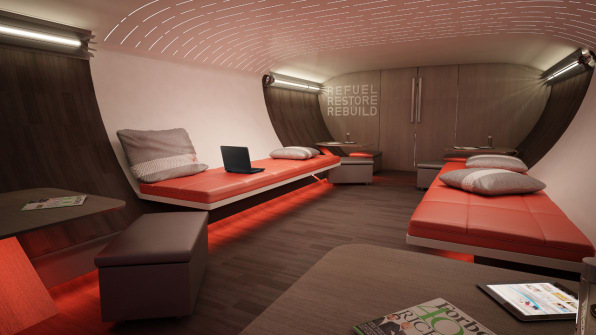 Athlete’s Plane [Image: courtesy Teague]
Athlete’s Plane [Image: courtesy Teague]PLANES WILL FEEL MORE LIKE HOTELS
The airplane seat is so 2017. According to Jeremy White, the design director in charge of transportation projects at London-based design firm Seymourpowell, the future of the first-class cabin isn’t about the seat. It’s about space.
The firm recently launched a concept called First Spaces based around a hotel model, where you can reserve a totally private single or a double room in the sky. A double cabin could be sold to two people traveling together, or to a solo traveler for a more premium rate. While originally conceived as a pitch for Singapore Airlines’ luxury A380 cabins, the firm retained the intellectual property and instead released the concept in early April. “It’s trying to challenge the business model of airlines,” White says.
White believes that while the sheer number of first-class cabins may decrease overall because they’ll be so expensive, the ones that remain onboard will become even more luxurious for those who are willing to pay. Since airlines want to win the business of the world’s super-luxury fliers, who might otherwise use a private jet, White thinks that the private, flexible design of First Spaces would be ideal for a new model of airline that strikes the balance between first class and private jets.
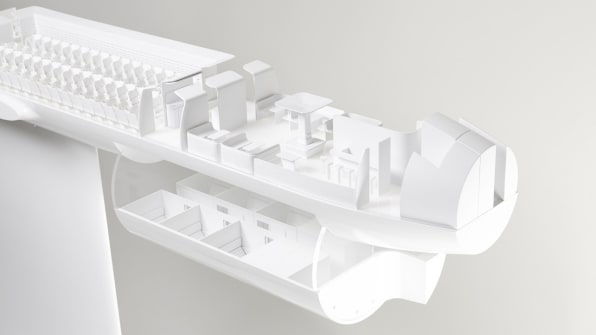 New Territory [Image: courtesy New Territory]The London-based design firm New Territory played on a similar idea in its design concept for the aircraft interior manufacturer Zodiac. The design reimagines the hierarchy of today’s cabins by adding more flexible spaces for passengers to access. A key element of the concept features more spacious private rooms for first-class fliers, with seats that morph into a full bed. Meant to give the experience of a “boutique hotel,” the ultimate luxury flying experience one day may be indistinguishable from a small hotel room.
New Territory [Image: courtesy New Territory]The London-based design firm New Territory played on a similar idea in its design concept for the aircraft interior manufacturer Zodiac. The design reimagines the hierarchy of today’s cabins by adding more flexible spaces for passengers to access. A key element of the concept features more spacious private rooms for first-class fliers, with seats that morph into a full bed. Meant to give the experience of a “boutique hotel,” the ultimate luxury flying experience one day may be indistinguishable from a small hotel room.In fact, the trend toward fully private suites in first class is already beginning to appear in some airline cabins. JetBlue’s Mint, which costs about $1,200 roundtrip from Los Angeles to New York, offers private seats that recline into a bed. Emirates’s first-class seats are also fully private and fully recline.
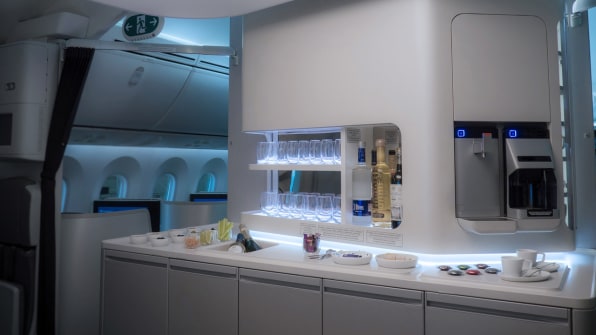 New Territory [Image: courtesy New Territory]
New Territory [Image: courtesy New Territory]YOU’RE STUCK TOGETHER. WHY NOT NETWORK?
While first class will feel more like a hotel experience, business class might feel more like a networking happy hour. Designers are trying to reflect the changes within the business world itself, where industry leaders are skewing younger and suits are giving way to hoodies and jeans.
“I think there’s a notion that the trappings of success are changing,” says Luke Miles, cofounder and director of New Territory and former head of design at Virgin Atlantic. “The view of people in business class is sometimes overly masculine and a bit sterile.”
Miles’s firm recently designed the business class cabins for Aero Mexico’s 787-9 planes with that cultural shift away from stuffiness in mind. For the business class’s social space–which is typically a bar–Miles and his team decided to focus instead on the kitchen. Their final design creates a kitchen-like space for passengers to take snacks and drinks that also doubles as a place to socialize. “People don’t always talk at a bar, but they do tend to chat in the kitchen,” he says. The result is meant to be more accessible for people who might not be as comfortable taking a seat at the bar.
“As business class gets younger, with companies with less hierarchy, less of an executive feel, we’ll start to see a different kind of design ethos,” says Hugo Jamson, the associate director of New Territory. “The privacy of the seat is reduced, offering more of that serendipity.”
In order to cater to younger businesspeople who may be more comfortable in a coworking space than in a boardroom, designers are looking to the social components of coworking spaces for inspiration. This could lead to a business-class cabin that’s more open to socializing and networking, while retaining the option for privacy in order to be productive.
“It comes down to flexibility, being able to have seats and [an] environment that can adapt to the changing needs of people,” says Seymourpowell’s White. “We see the need driven by the rising demands of being able to work anywhere–spaces that will be able to break down into working spaces and then change into more private spaces.”
The airline cabin of the future may not only be more social for business class fliers, though. Ohayon, of Icrave, believes that airlines will try to end the anxiety over who you’ll sit next to on a flight in economy by creating mini social networks where passengers can scout out people who have similar interests and request to be seated next to like-minded passengers. He believes these kinds of online social groups might lend themselves to people meeting in airports and on the plane itself–something the startup Planely has tried to do, with apparently limited success. It might take a lot more than a social network to get people to actually talk to each other in the enclosed space of an airplane cabin.
 Poppi [Image: courtesy Teague]
Poppi [Image: courtesy Teague]SORRY, ECONOMY FLIERS
Sadly, there are no breakthroughs in economy class seat design on the horizon, though designers are working on making the space you do get as comfortable as possible. “Price will still be a major driver in economy class,” says White, of Seymourpowell. “That’s not going to go away.”
Price will remain important for both passengers looking for the best deal and for airlines, which eek out a 5% profit each year. Driving profit is often at odds with improving passenger experience, especially in economy class. With this in mind, Seymourpowell designed a concept called Morph, in which seat width is fully customizable and customers can pay for a wider seat width. “That’s really trying to have a space that you can sell-out at maximum density so you can still drive the numbers game you need to make an airline work,” White says.
So the majority of changes to economy cabin seating have to do with slight ergonomic tweaks, not dramatic overalls. Instead, designers are focusing not on seating, but shared spaces. “Are we going to have more space? The answer is no,” says Luke Hawes, design director at the London-based firm Priestmangoode. “But we work on the living space that’s available. That’s the key in designing flexible seating. It’s not to design every seat that can become a bed. That’s not going to happen. But we can design them so at less busy times they can be more comfortable.”
 Poppi [Image: courtesy Teague]Hawes believes that the airlines will offer economy passengers more flexible space in parts of the aircraft where airlines can’t put seats, like parts of the luggage hold or crew rest areas. Those spaces don’t generate revenue for the aircraft, Hawes says, so they could be repurposed as “destination areas” like lounges, coffee bars, or children’s play areas. “A lot of people go to the lavatory to stretch their legs,” Hawes says. “It would be nice to have a destination to go to to stretch your legs that’s not the lavatory.”
Poppi [Image: courtesy Teague]Hawes believes that the airlines will offer economy passengers more flexible space in parts of the aircraft where airlines can’t put seats, like parts of the luggage hold or crew rest areas. Those spaces don’t generate revenue for the aircraft, Hawes says, so they could be repurposed as “destination areas” like lounges, coffee bars, or children’s play areas. “A lot of people go to the lavatory to stretch their legs,” Hawes says. “It would be nice to have a destination to go to to stretch your legs that’s not the lavatory.”For example, New Territory’s work for the aerospace equipment manufacturer Zodiac included what it calls a “light lounge,” which acts as both a corridor for easier boarding and a self-service snack station–or, during flight, just an open place to stretch your legs.
Economy passengers may see a few other perks, from free Wi-Fi to better entertainment, says Jim Peters, the CTO of airport technology company SITA. He predicts that connectivity in the air will soon follow the hotel model, where a high-speed connection will cost you, but a slower speed will be free. Some designers foresee virtual reality headsets making flying feel a lot less like flying; others see the in-flight entertainment (IFE) system taking on an even greater role.
“A lot of these additional areas onboard can be improved by just clever IFE tech. Maybe you can have a queuing system through your IFE, instead of physically standing [to wait for the bathroom,” says Hawes. “Likewise with snack areas, meal choice. All of this can be done through your IFE system. That’s much more pleasant than what we have today.”
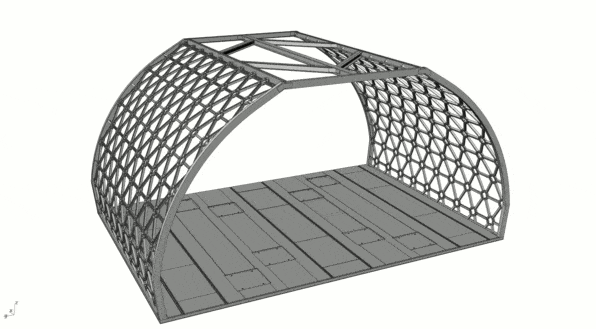
A CABIN THAT’S CUSTOMIZED TO YOU
While many of the experts I talked to described how existing first-, business-, and economy-class cabins would evolve, one designer is imagining a far more radical overhaul of the business of flight within the next 10 years.
A3 is Airbus’s innovation lab, which is focused on inventing the next generation of airplanes. There, the designer and engineer Jason Chua is heading up a project called Transpose, which imagines an entirely new airplane interior customized to whom is flying on a particular flight.
Chua says that today, most cabins only get incremental improvements because it’s so expensive and time-intensive to make changes to the inner structure; it’s difficult to integrate all the systems inside the airplane, from electrical wiring to plumbing to the mechanical systems. The goal behind Transpose, which is now a year old, is to make those systems all standard–so that the interiors themselves can be easily swapped in and out.
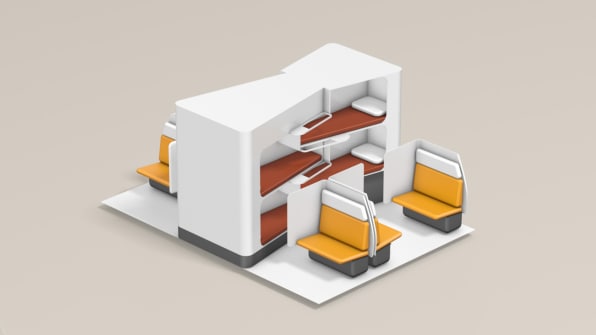 Transpose [Image: courtesy Transpose]To do this, Chua and his team are using an empty cargo airplane and creating a set of specs and design guidelines so that individual modules of seats can be installed quickly and efficiently. They’re currently building a full-scale prototype–which Chua hopes will be in the air in the next few months–while working on the business proposition in order to sell the idea to airlines. He says that several airlines are interested, but are skeptical about customer willingness to pay.
Transpose [Image: courtesy Transpose]To do this, Chua and his team are using an empty cargo airplane and creating a set of specs and design guidelines so that individual modules of seats can be installed quickly and efficiently. They’re currently building a full-scale prototype–which Chua hopes will be in the air in the next few months–while working on the business proposition in order to sell the idea to airlines. He says that several airlines are interested, but are skeptical about customer willingness to pay.Yet Chua believes that a fully customizable cabin would offer airlines a new type of business model, especially since they can tailor their cabins to the exact number of tickets they sell. For instance, Chua imagines that if an airline sold more business-class tickets than expected, it could quickly reconfigure the cabin to add more business-class seats. But an airline could also partner with a brand to maximize revenue for under-booked flights. If it didn’t sell all its economy-class seats, a module designed as a brand experience could add a valuable way to get passenger feedback and market data.
“Today, brand experiences on board figures on your tray table, napkins, in-flight safety,” Chua says. “All of a sudden when you have a module, you can create this new real estate that can be given over to brands. A movie studio putting together a spaceship to advertise a space-themed movie. There’s valuable messaging opportunity for brands, and that’s a new revenue stream for airlines.”
What It Will Feel Like To Fly In 2030
Designers are coming up with inventive ways to improve the air travel industry.
Or, on flights that are purely business class, Transpose would also allow an airline to actually turn the entire cabin into a coworking space to rival an on-the-ground WeWork. “There’s a lot of research that when you give people more ability to personalize, that’s associated with higher willingness to pay,” Chua says. “[Passengers] could book a ticket on a plane with the module they want, that had spaces conducive to productivity.”
Transpose remains an idea for now, but given how personalization has taken off in other industries like retail and hospitality, it could offer airlines a way to stay on top, especially if self-driving cars begin to encroach on their market. “I certainly think it’s a very attractive thing, and there will be a large market demand for it,” Chua says. “We’ll have to wait and find out.”
www.fotavgeia.blogspot.com


Δεν υπάρχουν σχόλια:
Δημοσίευση σχολίου